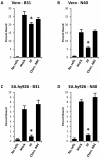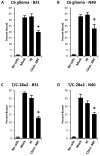Comparative molecular analyses of Borrelia burgdorferi sensu stricto strains B31 and N40D10/E9 and determination of their pathogenicity
- PMID: 22846633
- PMCID: PMC3511255
- DOI: 10.1186/1471-2180-12-157
Comparative molecular analyses of Borrelia burgdorferi sensu stricto strains B31 and N40D10/E9 and determination of their pathogenicity
Abstract
Background: Lyme disease in the United States is caused primarily by B. burgdorferi sensu stricto while other species are also prevalent in Europe. Genetic techniques have identified several chromosomal and plasmid-borne regulatory and virulence factors involved in Lyme pathogenesis. B31 and N40 are two widely studied strains of B. burgdorferi, which belong to two different 16 S-23 S rRNA spacer types (RST) and outer surface protein C (OspC) allelic groups. However, the presence of several known virulence factors in N40 has not been investigated. This is the first comprehensive study that compared these two strains both in vitro and using the mouse model of infection.
Results: Phylogenetic analyses predict B31 to be more infectious. However, our studies here indicate that N40D10/E9 is more infectious than the B31 strain at lower doses of inoculation in the susceptible C3H mice. Based-upon a careful analyses of known adhesins of these strains, it is predicted that the absence of a known fibronectin-glycosaminoglycan binding adhesin, bbk32, in the N40 strain could at least partially be responsible for reduction in its binding to Vero cells in vitro. Nevertheless, this difference does not affect the infectivity of N40D10/E9 strain. The genes encoding known regulatory and virulence factors critical for pathogenesis were detected in both strains. Differences in the protein profiles of these B. burgdorferi strains in vitro suggest that the novel, differentially expressed molecules may affect infectivity of B. burgdorferi. Further exacerbation of these molecular differences in vivo could affect the pathogenesis of spirochete strains.
Conclusion: Based upon the studies here, it can be predicted that N40D10/E9 disseminated infection at lower doses may be enhanced by its lower binding to epithelial cells at the site of inoculation due to the absence of BBK32. We suggest that complete molecular analyses of virulence factors followed by their evaluation using the mouse infection model should form the basis of determining infectivity and pathogenicity of different strains rather than simple phylogenetic group analyses. This study further emphasizes a need to investigate multiple invasive strains of B. burgdorferi to fully appreciate the pathogenic mechanisms that contribute to Lyme disease manifestations.
Figures





Similar articles
-
Detection of established virulence genes and plasmids to differentiate Borrelia burgdorferi strains.Infect Immun. 2012 Apr;80(4):1519-29. doi: 10.1128/IAI.06326-11. Epub 2012 Jan 30. Infect Immun. 2012. PMID: 22290150 Free PMC article.
-
Inactivation of the fibronectin-binding adhesin gene bbk32 significantly attenuates the infectivity potential of Borrelia burgdorferi.Mol Microbiol. 2006 Mar;59(5):1591-601. doi: 10.1111/j.1365-2958.2005.05042.x. Mol Microbiol. 2006. PMID: 16468997
-
Borrelia burgdorferi sensu stricto and Borrelia afzelii: Population structure and differential pathogenicity.Int J Med Microbiol. 2015 Oct;305(7):673-81. doi: 10.1016/j.ijmm.2015.08.017. Epub 2015 Aug 21. Int J Med Microbiol. 2015. PMID: 26341331
-
The need to unravel the twisted nature of the Borrelia burgdorferi sensu lato complex across Europe.Microbiology (Reading). 2020 May;166(5):428-435. doi: 10.1099/mic.0.000899. Microbiology (Reading). 2020. PMID: 32125267 Review.
-
Evolutionary aspects of emerging Lyme disease in Canada.Appl Environ Microbiol. 2015 Nov;81(21):7350-9. doi: 10.1128/AEM.01671-15. Epub 2015 Aug 21. Appl Environ Microbiol. 2015. PMID: 26296723 Free PMC article. Review.
Cited by
-
Phylogenomic Diversity Elucidates Mechanistic Insights into Lyme Borreliae-Host Association.mSystems. 2022 Aug 30;7(4):e0048822. doi: 10.1128/msystems.00488-22. Epub 2022 Aug 8. mSystems. 2022. PMID: 35938719 Free PMC article.
-
Outer surface protein polymorphisms linked to host-spirochete association in Lyme borreliae.Mol Microbiol. 2019 Apr;111(4):868-882. doi: 10.1111/mmi.14209. Epub 2019 Feb 27. Mol Microbiol. 2019. PMID: 30666741 Free PMC article. Review.
-
The Borrelia burgdorferi Glycosaminoglycan Binding Protein Bgp in the B31 Strain Is Not Essential for Infectivity despite Facilitating Adherence and Tissue Colonization.Infect Immun. 2018 Jan 22;86(2):e00667-17. doi: 10.1128/IAI.00667-17. Print 2018 Feb. Infect Immun. 2018. PMID: 29158428 Free PMC article.
-
BB0347, from the lyme disease spirochete Borrelia burgdorferi, is surface exposed and interacts with the CS1 heparin-binding domain of human fibronectin.PLoS One. 2013 Sep 27;8(9):e75643. doi: 10.1371/journal.pone.0075643. eCollection 2013. PLoS One. 2013. PMID: 24086600 Free PMC article.
-
Borrelia burgdorferi Strain-Specific Differences in Mouse Infectivity and Pathology.Pathogens. 2025 Apr 5;14(4):352. doi: 10.3390/pathogens14040352. Pathogens. 2025. PMID: 40333117 Free PMC article.
References
-
- Steere AC, Bartenhagen NH, Craft JE. The early clinical manifestations of Lyme disease. Ann Intern Med. 1983;99:76–82. - PubMed

